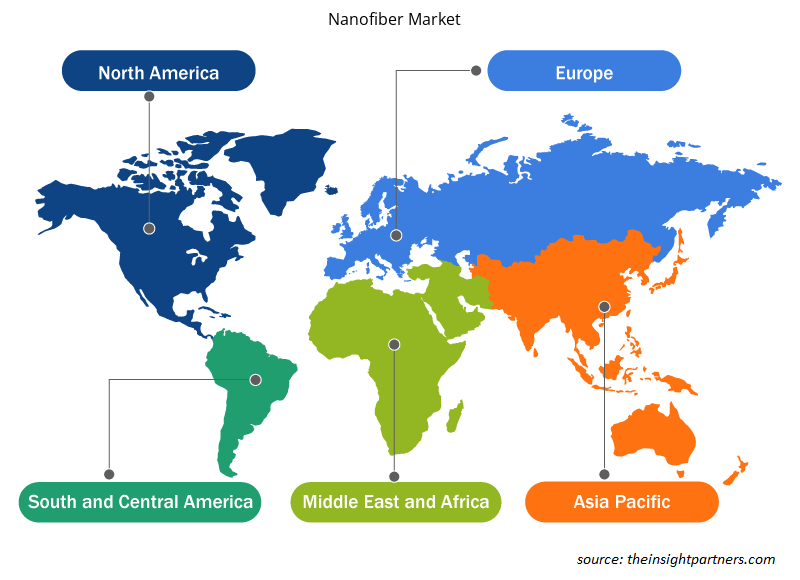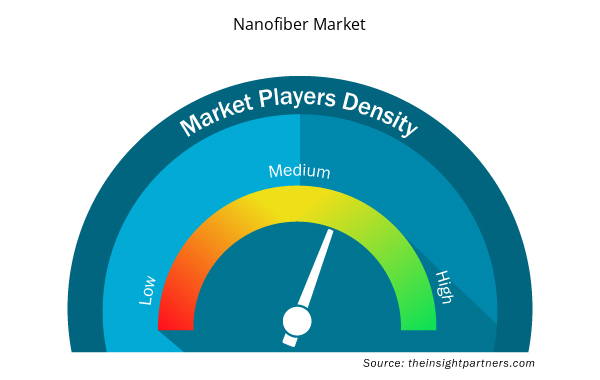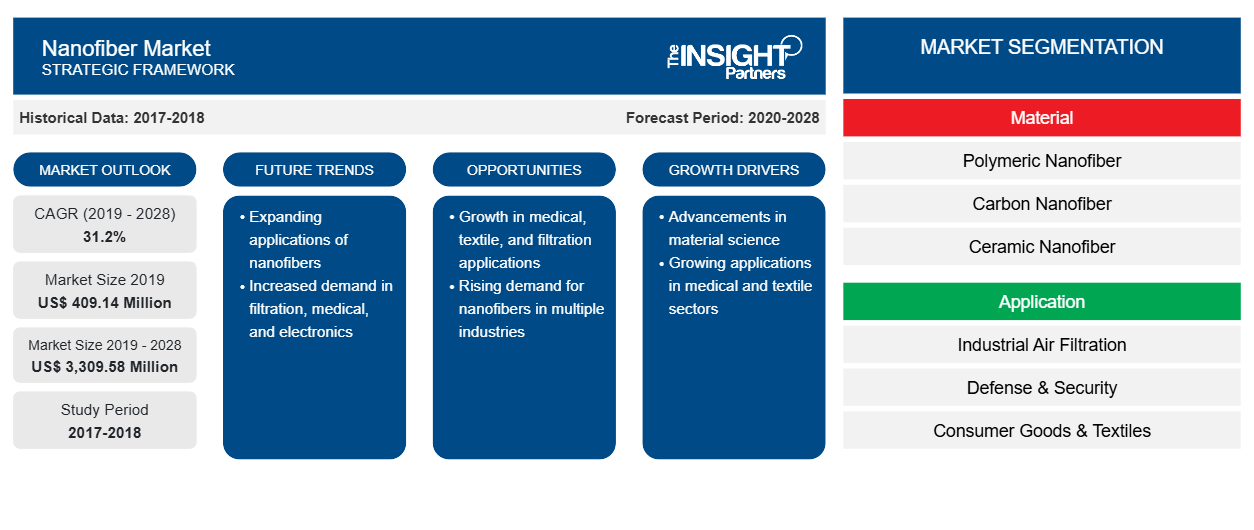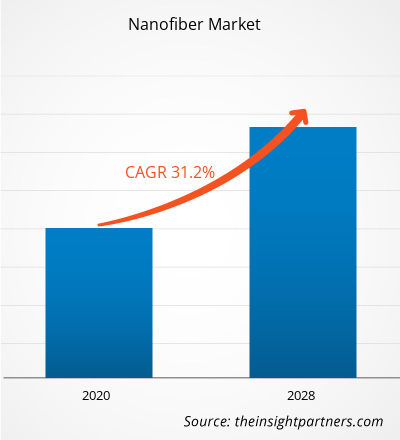بلغت قيمة سوق الألياف النانوية 409.14 مليون دولار أمريكي في عام 2019 ومن المتوقع أن تصل إلى 3،309.58 مليون دولار أمريكي بحلول عام 2028؛ ومن المتوقع أن ينمو بمعدل نمو سنوي مركب قدره 31.2٪ من عام 2020 إلى عام 2028.
الألياف النانوية عبارة عن ألياف يقل قطرها عن 1 ميكرومتر. تساعد هذه الألياف في تعزيز كفاءة الترشيح مع انخفاض طفيف نسبيًا في النفاذية. تعد الوتيرة السريعة للتصنيع والتسويق المتزايد لمنتجات الألياف النانوية مع زيادة التطبيقات الصناعية والجهود المستمرة في الابتكارات التكنولوجية وزيادة استثمارات البحث والتطوير من بين العوامل المهمة التي تساهم في نمو سوق الألياف النانوية .
في عام 2019، كانت منطقة آسيا والمحيط الهادئ أكبر سوق للألياف النانوية. وتعد منطقة آسيا والمحيط الهادئ موطنًا للعديد من البلدان النامية التي تشهد نموًا كبيرًا في قطاع التصنيع لديها؛ وأصبحت المنطقة مركزًا عالميًا للتصنيع. ومن بين تطور الصين إلى مركز تصنيع عالي المهارة، تجتذب بلدان نامية أخرى مثل الهند وكوريا الجنوبية وتايوان وفيتنام العديد من الشركات التي تسعى إلى نقل مرافق التصنيع منخفضة إلى متوسطة المهارة إلى البلدان المجاورة ذات تكلفة العمالة المنخفضة. كما ترحب حكومات هذه البلدان بمثل هذه الشركات من خلال تحسين أفكار الاستثمار أو تشجيع الاستثمارات الأجنبية المباشرة.
لقد أثر فيروس كورونا المستجد سلبًا على الاقتصادات والصناعات في مختلف البلدان بسبب عمليات الإغلاق التي فرضتها الحكومات وحظر السفر وإغلاق الشركات. تعد صناعة الكيماويات والمواد واحدة من الصناعات الرئيسية التي تعاني من اضطرابات خطيرة في شكل انقطاع سلسلة التوريد وإلغاء الأحداث التكنولوجية وإغلاق المكاتب. أدى إغلاق العديد من المصانع في أمريكا الشمالية وأوروبا وآسيا والمحيط الهادئ وأمريكا الجنوبية والشرق الأوسط وأفريقيا إلى تقييد سلسلة التوريد العالمية وإرباك أنشطة التصنيع وجداول التسليم ومبيعات المنتجات. علاوة على ذلك، توقعت العديد من الشركات بالفعل تأخيرات محتملة في تسليم المنتجات وانخفاض مبيعات منتجاتها في المستقبل. تعمل حظر السفر الذي فرضته دول في أوروبا وآسيا وأمريكا الشمالية على إعاقة فرص التعاون والشراكات التجارية. بالإضافة إلى هذه القيود، فإن التوافر المحدود للمهنيين العاملين وانخفاض مستويات الإنتاج بسبب تدابير التباعد الاجتماعي هي العوامل التي تعيق الأنشطة في صناعة الكيماويات والمواد، فضلاً عن الأسواق المختلفة المرتبطة بها. تستأنف العديد من البلدان الآن الحياة الطبيعية، في حين تشهد العديد منها موجة ثانية من تفشي المرض. وبالإضافة إلى ذلك، فمن المرجح أن يتغير الوضع في الأشهر المقبلة بفضل حملات التطعيم.
قم بتخصيص هذا التقرير ليناسب متطلباتك
ستحصل على تخصيص لأي تقرير - مجانًا - بما في ذلك أجزاء من هذا التقرير، أو تحليل على مستوى الدولة، وحزمة بيانات Excel، بالإضافة إلى الاستفادة من العروض والخصومات الرائعة للشركات الناشئة والجامعات
- احصل على أهم اتجاهات السوق الرئيسية لهذا التقرير.ستتضمن هذه العينة المجانية تحليلاً للبيانات، بدءًا من اتجاهات السوق وحتى التقديرات والتوقعات.
رؤى السوق
الوتيرة السريعة للتصنيع والحاجة إلى الحد من الانبعاثات الضارة من المنشآت الصناعية
يشهد قطاع التصنيع العالمي توسعًا سريعًا مع قيام المزيد من المناطق الجديدة بالاستثمار في تبني مصانع التصنيع في مناطقها. وفقًا لاتحاد الصين للوجستيات والمشتريات (CFLP)، بلغ مؤشر مديري المشتريات (PMI) لقطاع التصنيع العالمي 55.1 في أكتوبر 2017، بينما كان 55.9 في سبتمبر 2017؛ ومع ذلك، فإن المؤشر بشكل عام في ذروته في هذه الأشهر. بلغ مؤشر مديري المشتريات ~53.5 منذ بداية عام 2017، مما يدل على التعافي القوي لقطاع التصنيع في البلدان المتقدمة، وزيادة التقدم الصناعي في الاقتصادات الناشئة، وتكثيف أسعار السلع الأساسية في السوق العالمية. ومن المتوقع أن يحتضن قطاع التصنيع المتنامي التقدم التكنولوجي للحصول على ميزة تنافسية من خلال تعزيز إنتاجية المصنع وكذلك من خلال مواكبة التغييرات في تفضيلات العملاء. يمر قطاع التصنيع حاليًا بنهضة تكنولوجية، والتي تغير من آفاق وعمليات المصنع الحديث. ومع ذلك، فإن تضخم عمليات الصناعات المختلفة يساهم أيضًا في المخاطر البيئية، وخاصة في المدن الصناعية الكبرى. كما يؤثر التصنيع الضخم أيضًا على صحة السكان المقيمين بالقرب من هذه الشركات من خلال الانبعاثات السامة.
رؤى المواد
بناءً على المادة، يتم تقسيم سوق الألياف النانوية إلى ألياف نانوية بوليمرية وألياف نانوية كربونية وألياف نانوية سيراميكية وألياف نانوية زجاجية وغيرها. قاد قطاع الألياف النانوية الكربونية سوق الألياف النانوية بأكبر حصة في عام 2020. يتم تصنيع الألياف النانوية الكربونية عن طريق إزالة العناصر غير الكربونية من البوليمرات الاصطناعية والبوليمرات الحيوية في درجات حرارة عالية للغاية. في طريقة المحفز العائم لتصنيع الألياف النانوية الكربونية، تُستخدم معادن مختلفة في الأشكال المسحوقة أو الداعمة ككيانات محفزة. الرقائق والشاش والأسلاك وما إلى ذلك هي محفزات أخرى تستخدم في إنتاج الألياف النانوية. تتميز الألياف النانوية الكربونية بانقطاع وتوافق كبيرين، من بين خصائص فيزيائية أخرى، كما أنها شديدة الجرافيتية. لديها خصائص ميكانيكية ممتازة مع موصلية كهربائية وحرارية عالية. تشمل مجالات تطبيق الألياف النانوية الكربونية المواد البلاستيكية الحرارية، والإيلاستومرات، والمواد الصلبة بالحرارة، والسيراميك، والإيلاستومرات، والمعادن. بالإضافة إلى ذلك، نظرًا لقوتها العالية في الشد والتوصيل الحراري والكهربائي، تُستخدم ألياف الكربون النانوية على نطاق واسع في السقالات الهندسية العظمية والأسنان والأنسجة.
رؤى التطبيق
بناءً على التطبيق، يتم تقسيم سوق الألياف النانوية إلى ترشيح الهواء الصناعي والدفاع والأمن والسلع الاستهلاكية والمنسوجات والمكونات الإلكترونية والطاقة والرعاية الصحية وعلوم الحياة والكيمياء والبيئة وغيرها. قاد قطاع الرعاية الصحية وعلوم الحياة السوق بأكبر حصة في عام 2020. المواد القابلة للتحلل البيولوجي المستخدمة في الألياف النانوية هي الأنسب للصناعات الطبية والرعاية الصحية. علاوة على ذلك، يسمح دمج المواد المضافة بتعدد وظائف هذه الألياف النانوية. نظرًا لأنه يمكن التحكم في بنيتها وحجمها، يمكن استخدامها في هندسة الأنسجة. تشمل بعض التطبيقات الرئيسية للألياف النانوية في صناعات العلوم الحيوية والأدوية توصيل الأدوية وشفاء الجروح وهندسة الأنسجة والمنسوجات الحاجزة.
تشمل الجهات الفاعلة الرئيسية في سوق الألياف النانوية شركة Ahlstrom-Munksjo؛ وشركة Asahi Kasei Corporation؛ وشركة Donaldson Company, Inc.؛ وشركة DuPont؛ وشركة Nanofibers Solution LLC, Inc.؛ وشركة Toray Industries, Inc.؛ وشركة Espin Technologies؛ وشركة Elmarco SRO؛ وشركة Mempro Ltd.؛ وشركة Revolution Fibers Ltd. وتركز الشركات الكبرى في السوق على استراتيجيات مثل عمليات الدمج والاستحواذ وإطلاق المنتجات لتوسيع حضورها الجغرافي وقاعدة المستهلكين. على سبيل المثال، في عام 2018، قدمت شركة Donaldson نظامًا مبتكرًا لتسهيل اختيار مرشح توربينات الغاز على المشغلين لاختيار مرشحات الهواء البديلة، وتطوير اختبارات معملية لقياس معدل استرداد النبضة وإحكام الماء.
تقرير يسلط الضوء على
- اتجاهات الصناعة التقدمية في سوق الألياف النانوية العالمية لمساعدة اللاعبين على تطوير استراتيجيات فعالة طويلة الأجل
- استراتيجيات نمو الأعمال التي تتبناها الشركات العاملة في الأسواق المتقدمة والنامية
- التحليل الكمي لسوق الألياف النانوية العالمية من عام 2017 إلى عام 2027
- تقدير الطلب على الألياف النانوية عبر مختلف الصناعات
- تحليل PEST لتوضيح فعالية المشترين والموردين العاملين في الصناعة للتنبؤ بنمو السوق
- التطورات الأخيرة لفهم سيناريو السوق التنافسي والطلب على الألياف النانوية
- اتجاهات السوق والتوقعات إلى جانب العوامل التي تدفع وتكبح نمو سوق الألياف النانوية
- استراتيجيات تنويرية تدعم الاهتمام التجاري بنمو سوق الألياف النانوية العالمية، لتسهيل عملية صنع القرار
- حجم سوق الألياف النانوية في مختلف مناطق السوق
- نظرة عامة تفصيلية وتقسيم سوق الألياف النانوية، إلى جانب ديناميكيات الصناعة
- حجم سوق الألياف النانوية في مناطق مختلفة مع فرص نمو واعدة
رؤى إقليمية حول سوق الألياف النانوية
لقد قام المحللون في Insight Partners بشرح الاتجاهات والعوامل الإقليمية المؤثرة على سوق Nanofiber طوال فترة التوقعات بشكل شامل. يناقش هذا القسم أيضًا قطاعات سوق Nanofiber والجغرافيا في جميع أنحاء أمريكا الشمالية وأوروبا ومنطقة آسيا والمحيط الهادئ والشرق الأوسط وأفريقيا وأمريكا الجنوبية والوسطى.

- احصل على البيانات الإقليمية المحددة لسوق الألياف النانوية
نطاق تقرير سوق الألياف النانوية
| سمة التقرير | تفاصيل |
|---|---|
| حجم السوق في عام 2019 | 409.14 مليون دولار أمريكي |
| حجم السوق بحلول عام 2028 | 3,309.58 مليون دولار أمريكي |
| معدل النمو السنوي المركب العالمي (2019 - 2028) | 31.2% |
| البيانات التاريخية | 2017-2018 |
| فترة التنبؤ | 2020-2028 |
| القطاعات المغطاة | حسب المادة
|
| المناطق والدول المغطاة | أمريكا الشمالية
|
| قادة السوق وملفات تعريف الشركات الرئيسية |
|
كثافة اللاعبين في سوق الألياف النانوية: فهم تأثيرها على ديناميكيات الأعمال
يشهد سوق الألياف النانوية نموًا سريعًا، مدفوعًا بالطلب المتزايد من المستخدم النهائي بسبب عوامل مثل تفضيلات المستهلكين المتطورة والتقدم التكنولوجي والوعي المتزايد بفوائد المنتج. ومع ارتفاع الطلب، تعمل الشركات على توسيع عروضها والابتكار لتلبية احتياجات المستهلكين والاستفادة من الاتجاهات الناشئة، مما يؤدي إلى زيادة نمو السوق.
تشير كثافة اللاعبين في السوق إلى توزيع الشركات أو المؤسسات العاملة في سوق أو صناعة معينة. وهي تشير إلى عدد المنافسين (اللاعبين في السوق) الموجودين في مساحة سوق معينة نسبة إلى حجمها أو قيمتها السوقية الإجمالية.
الشركات الرئيسية العاملة في سوق الألياف النانوية هي:
- أهلستروم-مونكسجو
- شركة أساهي كاساي
- شركة دونالدسون المحدودة
- دوبونت
- نانوفايبرز سوليوشن ذ.م.م.
إخلاء المسؤولية : الشركات المذكورة أعلاه ليست مرتبة بأي ترتيب معين.

- احصل على نظرة عامة على أهم اللاعبين الرئيسيين في سوق الألياف النانوية
سوق الألياف النانوية حسب المادة
- ألياف نانوية بوليمرية
- ألياف الكربون النانوية
- ألياف نانوية سيراميكية
- الألياف الزجاجية النانوية
- آحرون
سوق الألياف النانوية – حسب التطبيق
- تنقية الهواء الصناعي
- السلع الاستهلاكية والمنسوجات
- المكونات الإلكترونية
- الدفاع والأمن
- الطاقة والقوة
- الرعاية الصحية وعلوم الحياة
- المواد الكيميائية والبيئة
- آحرون
نبذة عن الشركة
- أهلستروم-مونكسجو،
- شركة أساهي كاساي
- شركة دونالدسون المحدودة
- دوبونت
- نانوفايبرز سوليوشن ذ.م.م.
- شركة توراي للصناعات المحدودة
- اسبين تكنولوجي
- شركة إلماركو إس آر أو
- شركة ميمبرو المحدودة
- شركة ريفولوشن فايبرز المحدودة
- التحليل التاريخي (سنتان)، السنة الأساسية، التوقعات (7 سنوات) مع معدل النمو السنوي المركب
- تحليل PEST و SWOT
- حجم السوق والقيمة / الحجم - عالميًا وإقليميًا وقطريًا
- الصناعة والمنافسة
- مجموعة بيانات Excel



Report Coverage
Revenue forecast, Company Analysis, Industry landscape, Growth factors, and Trends

Segment Covered
This text is related
to segments covered.

Regional Scope
North America, Europe, Asia Pacific, Middle East & Africa, South & Central America

Country Scope
This text is related
to country scope.
الأسئلة الشائعة
Polymeric nanofibers are generated from naturally or artificially synthesized polymers. Natural polymers include collagen, silk fibroin, cellulose, gelatin, chitosan and polysaccharides. While synthetic polymers include nylon, polyacrylonitrile, polystyrene, polycarbonate, Polyethylene terephthalate (PET), and water-soluble polymers. These fibers possess high specific area, excellent porosity and better flexibility in surface functionalities. They find enormous applications in various domains such as filtration, material reinforcements, energy storage, sensor devices and others. The growing demand from energy, water, chemicals, pharmaceutical, biotechnology, and food & beverage industries are expected to drive the market for polymer nanofibers across the globe. Apart from this, they are utilized in bone tissue engineering applications in the medical sector which further fueling the demand for polymer nanofiber globally.
The major players operating in the global nanofiber market are Ahlstrom-Munksjo, Asahi Kasei Corporation, Donaldson Company, Inc., DuPont, Nanofibers Solution LLC, Inc., Toray Industries, Inc., Espin Technologies, Elmarco S.R.O., Mempro Ltd., and Revolution Fibers Ltd.
In 2019, Asia Pacific contributed to the largest share in the global nanofiber market. The improving infrastructure, rising domestic consumption and lower costs are some of the factors attracting manufacturing companies in these countries. The development of manufacturing hub creates the demand for nanofibers to be used for a diverse range of purposes. Several governments have taken initiatives such as Made in China 2025, and Make in India, among others to propel the growth of manufacturing sector which further supports the growth of nanofibers market.
Trends and growth analysis reports related to Chemicals and Materials : READ MORE..
The List of Companies - Global Nanofiber Market
- Ahlstrom-Munksjo
- Asahi Kasei Corporation
- Donaldson Company, Inc
- DuPont
- Nanofibers Solution LLC, Inc.
- Toray Industries, Inc
- Espin Technologies
- Elmarco S.R.O.
- Mempro Ltd.
- Revolution Fibers Ltd.
The Insight Partners performs research in 4 major stages: Data Collection & Secondary Research, Primary Research, Data Analysis and Data Triangulation & Final Review.
- Data Collection and Secondary Research:
As a market research and consulting firm operating from a decade, we have published and advised several client across the globe. First step for any study will start with an assessment of currently available data and insights from existing reports. Further, historical and current market information is collected from Investor Presentations, Annual Reports, SEC Filings, etc., and other information related to company’s performance and market positioning are gathered from Paid Databases (Factiva, Hoovers, and Reuters) and various other publications available in public domain.
Several associations trade associates, technical forums, institutes, societies and organization are accessed to gain technical as well as market related insights through their publications such as research papers, blogs and press releases related to the studies are referred to get cues about the market. Further, white papers, journals, magazines, and other news articles published in last 3 years are scrutinized and analyzed to understand the current market trends.
- Primary Research:
The primarily interview analysis comprise of data obtained from industry participants interview and answers to survey questions gathered by in-house primary team.
For primary research, interviews are conducted with industry experts/CEOs/Marketing Managers/VPs/Subject Matter Experts from both demand and supply side to get a 360-degree view of the market. The primary team conducts several interviews based on the complexity of the markets to understand the various market trends and dynamics which makes research more credible and precise.
A typical research interview fulfils the following functions:
- Provides first-hand information on the market size, market trends, growth trends, competitive landscape, and outlook
- Validates and strengthens in-house secondary research findings
- Develops the analysis team’s expertise and market understanding
Primary research involves email interactions and telephone interviews for each market, category, segment, and sub-segment across geographies. The participants who typically take part in such a process include, but are not limited to:
- Industry participants: VPs, business development managers, market intelligence managers and national sales managers
- Outside experts: Valuation experts, research analysts and key opinion leaders specializing in the electronics and semiconductor industry.
Below is the breakup of our primary respondents by company, designation, and region:

Once we receive the confirmation from primary research sources or primary respondents, we finalize the base year market estimation and forecast the data as per the macroeconomic and microeconomic factors assessed during data collection.
- Data Analysis:
Once data is validated through both secondary as well as primary respondents, we finalize the market estimations by hypothesis formulation and factor analysis at regional and country level.
- Macro-Economic Factor Analysis:
We analyse macroeconomic indicators such the gross domestic product (GDP), increase in the demand for goods and services across industries, technological advancement, regional economic growth, governmental policies, the influence of COVID-19, PEST analysis, and other aspects. This analysis aids in setting benchmarks for various nations/regions and approximating market splits. Additionally, the general trend of the aforementioned components aid in determining the market's development possibilities.
- Country Level Data:
Various factors that are especially aligned to the country are taken into account to determine the market size for a certain area and country, including the presence of vendors, such as headquarters and offices, the country's GDP, demand patterns, and industry growth. To comprehend the market dynamics for the nation, a number of growth variables, inhibitors, application areas, and current market trends are researched. The aforementioned elements aid in determining the country's overall market's growth potential.
- Company Profile:
The “Table of Contents” is formulated by listing and analyzing more than 25 - 30 companies operating in the market ecosystem across geographies. However, we profile only 10 companies as a standard practice in our syndicate reports. These 10 companies comprise leading, emerging, and regional players. Nonetheless, our analysis is not restricted to the 10 listed companies, we also analyze other companies present in the market to develop a holistic view and understand the prevailing trends. The “Company Profiles” section in the report covers key facts, business description, products & services, financial information, SWOT analysis, and key developments. The financial information presented is extracted from the annual reports and official documents of the publicly listed companies. Upon collecting the information for the sections of respective companies, we verify them via various primary sources and then compile the data in respective company profiles. The company level information helps us in deriving the base number as well as in forecasting the market size.
- Developing Base Number:
Aggregation of sales statistics (2020-2022) and macro-economic factor, and other secondary and primary research insights are utilized to arrive at base number and related market shares for 2022. The data gaps are identified in this step and relevant market data is analyzed, collected from paid primary interviews or databases. On finalizing the base year market size, forecasts are developed on the basis of macro-economic, industry and market growth factors and company level analysis.
- Data Triangulation and Final Review:
The market findings and base year market size calculations are validated from supply as well as demand side. Demand side validations are based on macro-economic factor analysis and benchmarks for respective regions and countries. In case of supply side validations, revenues of major companies are estimated (in case not available) based on industry benchmark, approximate number of employees, product portfolio, and primary interviews revenues are gathered. Further revenue from target product/service segment is assessed to avoid overshooting of market statistics. In case of heavy deviations between supply and demand side values, all thes steps are repeated to achieve synchronization.
We follow an iterative model, wherein we share our research findings with Subject Matter Experts (SME’s) and Key Opinion Leaders (KOLs) until consensus view of the market is not formulated – this model negates any drastic deviation in the opinions of experts. Only validated and universally acceptable research findings are quoted in our reports.
We have important check points that we use to validate our research findings – which we call – data triangulation, where we validate the information, we generate from secondary sources with primary interviews and then we re-validate with our internal data bases and Subject matter experts. This comprehensive model enables us to deliver high quality, reliable data in shortest possible time.


 احصل على عينة مجانية لهذا التقرير
احصل على عينة مجانية لهذا التقرير